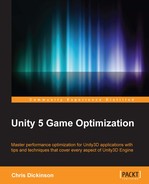One way of describing performance optimization is "the act of stripping away unnecessary tasks that spend valuable resources". We can do the same and maximize our own productivity through minimizing wasted effort. Effective use of the tools we have at our disposal is of paramount importance. It would serve us well to optimize our own workflow by keeping aware of some best practices and techniques.
Most, if not all, advice for using any kind of data-gathering tool properly can be summarized into three different strategies:
- Understanding the tool
- Reducing noise
- Focusing on the issue
The Profiler is an arguably well-designed and intuitive tool, so understanding the majority of its feature set can be gained by simply spending an hour or two exploring its options with a test project and reading its documentation. The more we know about our tool in terms of its benefits, pitfalls, features, and limitations, the more sense we can make of the information it is giving us, so it is worth spending the time to use it in a playground setting. We don't want to be two weeks away from release, with a hundred performance defects to fix, with no idea how to do performance analysis efficiently!
For example, always remain aware of the relative nature of the Timeline View's graphical display. Just because a spike or resting state in the Timeline seems large and threatening, does not necessarily mean there is a performance issue. Because the Timeline View does not provide values on its vertical axis, and automatically readjusts this axis based on the content of the last 300 frames, it can make small spikes appear to be a bigger problem than they really are. Several areas in the Timeline provide helpful benchmark bars, giving a glimpse of how the application was performing at that moment. These should be used to determine the magnitude of the problem. Don't let the Profiler trick us into thinking that big spikes are always bad. As always, it's only important if the user will notice it!
As an example, if a large CPU usage spike does not exceed the 60 FPS or 30 FPS benchmark bars (depending on the application's target frame rate), then it would be wise to ignore it and search elsewhere for CPU performance issues, as no matter how much we improve the offending piece of code it will probably never be noticed by the end user, and isn't a critical issue that affects product quality.
The classical definition of noise in computer science is meaningless data, and a batch of profiling data that was blindly captured with no specific target in mind is always full of data which won't interest us. More data takes more time to mentally process and filter, which can be very distracting. One of the best methods to avoid this it to simply reduce the amount of data we need to process, by stripping away any data deemed nonvital to the current situation.
Reducing clutter in the Profiler's graphical interface will make it easier to determine which component is causing a spike in resource usage. Remember to use the colored boxes in each Timeline area to narrow the search. However, these settings are autosaved in the Editor, so be sure to re-enable them for the next profiling session as this might cause us to miss something important next time!
Also, GameObjects can be deactivated to prevent them from generating profiling data, which will also help reduce clutter in our profiling data. This will naturally cause a slight performance boost for each object we deactivate. But, if we're gradually deactivating objects and performance suddenly becomes significantly more acceptable when a specific object is deactivated, then clearly that object is related to the root cause of the problem.
This category may seem redundant, given that we've already covered reducing noise. All we should have left is the issue at hand, right? Not exactly. Focus is the skill of not letting ourselves become distracted by inconsequential tasks and wild goose chases.
Recall that profiling with the Unity Profiler comes with a minor performance cost. This cost is even more severe when using the Deep Profiling option. We might even introduce more minor performance costs into our application with additional logging and so on. It's easy to forget when and where we introduced profiling code if the hunt continues for several hours.
We are effectively changing the result by measuring it. Any changes we implement during data sampling can sometimes lead us to chase after nonexistent bugs in the application, when we could have saved ourselves a lot of time by attempting to replicate the scenario under non-profiling conditions. If the bottleneck is reproducible and noticeable without profiling, then it's a candidate to begin an investigation. But if new bottlenecks keep appearing in the middle of an existing investigation, then keep in mind that they could simply be bottlenecks we recently introduced with test code, and not something that's been newly exposed.
Finally, when we have finished profiling, have completed our fixes, and are now ready to move on to the next investigation, we should make sure to profile the application one last time to verify that the changes have had the intended effect.
